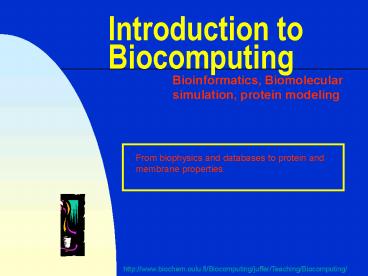Introduction to Biocomputing PowerPoint PPT Presentation
1 / 14
Title: Introduction to Biocomputing
1
Introduction to Biocomputing
- Bioinformatics, Biomolecular simulation, protein
modeling
From biophysics and databases to protein and
membrane properties.
http//www.biochem.oulu.fi/Biocomputing/juffer/Tea
ching/Biocomputing/
2
Overview of course
- Biomolecular simulation techniques Basic
principles. - Structural Bioinformatics Special subjects.
- Protein and membrane modeling Real applications.
- Examination Article presentations
- Two papers to read.
3
Requirements
- Knowledge of physical chemistry
- Thermodynamics, chemistry.
- Knowledge of protein structures
- Protein structure.
- Knowledge of mechanics
- Concept of potential and kinetic energy.
- Concept of force.
4
Biocomputing (1)
- New scientific discipline.
- Only in the 1990s the importance of Biocomputing
has been realized - Genome project (bioinformatics).
- Finland
- Several research groups, including Oulu, Turku,
Tampere and Kuopio - Increasingly higher chances for employment in
this sector.
5
Biocomputing is multidisciplinary
6
Biocomputing (3)
- Bioinformatics
- proteomics
- data mining
- sequence alignment
- analysis genome sequence data
- Biomolecular
- simulation
- ligand affinity calculation
- protein and membrane dynamics
- protein function, enzymatic action
- electrostatics
- Protein modeling
- protein structure prediction (threading
techniques, homology building) - Ligand modelling, docking
Physics
Database, Statistics
7
Computer simulation
- A simulation models or emulates on a single
computer or on a collection of computers, the
behavior of a given biological process with the
objective to predict various quantitative
properties. - A simulation is an imitation of some real thing,
state of affairs, or process. The act of
simulating something generally entails
representing certain key characteristics or
behaviors of a selected physical or abstract
system. - Advanced computer programs can simulate weather
conditions, electronic circuits, chemical
reactions, atomic reactions, even biological
processes.
8
Drug discovery
Drug discovery in the next millenium
Target identification
After Ohlstein et al., Annu. Rev. Pharmacol.
Toxicol. 40, 177, 2000
9
List of topics (1)
- Biomolecular simulation techniques
- Hierarchical modeling ? Different levels of
description. - Statistical thermodynamics.
- Molecular dynamics.
- Brownian dynamics.
- Monte Carlo.
- Energy minimization techniques.
- And more
10
Theoretical Enzymology
Quantum chemistry/Molecular mechanics (fs).
Protein dynamics
Molecular dynamics (ps to ns).
Interfacial processes
Coarse-grained dynamics (µs to ms).
Protein translation
Stochastic modeling (ms to s).
Tumor growth
Multiple scale modeling (months to years).
Larger length and longer time scales. Less
molecular detail.
11
Simulation of ribosome motion along mRNA
Protein adsorption
Concentrate on behavior
Peroxisomal import mechanism
Tumor growth
12
List of topics (2)
- Structural bioinformatics
- Protein ligand design.
- Protein structure prediction
- Homology building.
- Threading.
- Ab Initio prediction.
- Protein engineering.
- And more
13
List of topics (3)
- Protein and membrane modeling
- Protein dynamics.
- Free energy calculations
- Protein-ligand affinity.
- pKa calculations and electrostatics.
- Protein engineering.
- Solvent effects.
- Membrane simulations.
- Simulation of protein folding.
- And more
14
Mathematics, Physics
- Quantitative way of explanation
- Basic calculus.
- Qualitative way of explanation
- Not always satisfactory.

